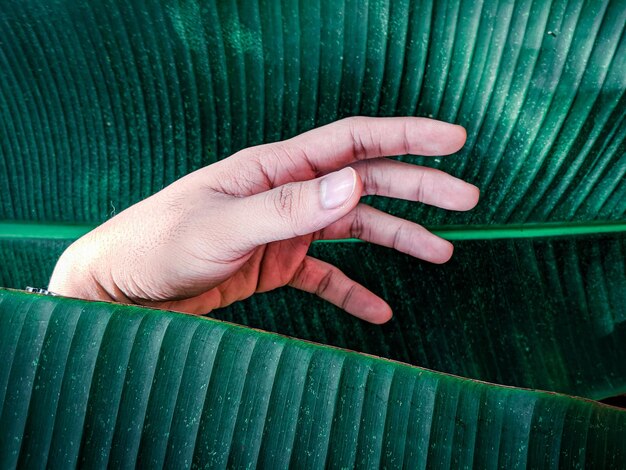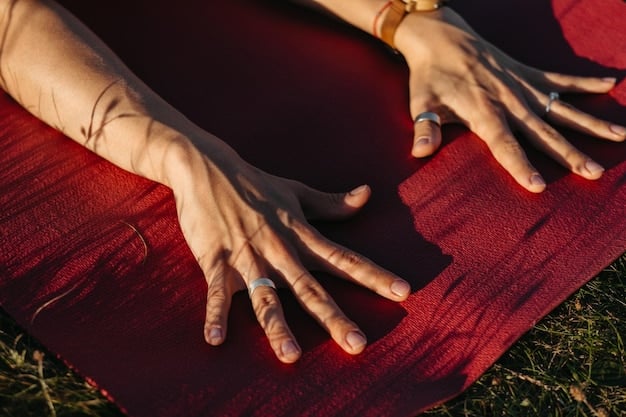Mudra Meditation: Enhance Focus & Deepen Your Practice

Mudra meditation uses specific hand gestures to channel energy flow, enhance focus, and deepen your meditation practice, transforming simple hand positions into powerful tools for mental clarity and spiritual growth.
Are you looking to enhance your meditation practice and achieve deeper focus? Mudra meditation can be a powerful tool to help you channel energy, focus your mind, and deepen your spiritual connection using simple hand gestures.
What is Mudra Meditation?
Mudra meditation involves the use of specific hand gestures, known as mudras, to influence the flow of energy within the body and mind. These gestures are believed to have a profound impact on our consciousness, promoting relaxation, focus, and overall well-being.
By incorporating mudras into your meditation practice, you can unlock new dimensions of awareness and cultivate a deeper sense of inner peace.
The Ancient Roots of Mudras
Mudras have ancient roots in Hinduism and Buddhism, often depicted in statues and artwork. These sacred hand gestures are believed to connect us to universal energies.
How Mudras Work
Each mudra is thought to stimulate specific areas of the brain and influence the flow of prana, or life force energy. By consciously forming these gestures, you can direct energy where it is needed most, promoting balance and harmony within yourself.

- Energy Flow: Mudras redirect and balance energy within the body.
- Brain Stimulation: Specific gestures activate different areas of the brain.
- Consciousness: Mudras influence your state of mind and awareness.
- Spiritual Connection: They can enhance your connection to the divine.
In essence, mudra meditation is a powerful way to harness the innate wisdom of your body and mind, using simple gestures to unlock profound states of awareness and well-being. By consciously engaging with mudras, you invite a deeper connection to your inner self and the world around you.
Benefits of Incorporating Mudras in Meditation
Adding mudras to your meditation offers a multitude of benefits, enhancing both your mental and physical well-being. These gestures can help to calm the mind, reduce stress, improve focus, and promote overall balance within the body.
By consistently practicing mudra meditation, you can experience a profound sense of inner peace and harmony.
Mental Clarity and Focus
Mudras can help to clear mental clutter and enhance focus, making it easier to quiet the mind during meditation. This clarity promotes a deeper sense of awareness and presence.
Stress Reduction
Certain mudras are known for their calming properties, helping to reduce stress and anxiety. By engaging these gestures, you can activate the relaxation response and foster a sense of tranquility.
Emotional Balance
Mudras can also help to balance emotions, promoting a sense of stability and well-being. They can assist in releasing negative emotions and cultivating feelings of joy and contentment.
- Improved Focus: Mudras enhance concentration during meditation.
- Stress Relief: Calming gestures reduce anxiety and tension.
- Emotional Well-being: Balanced emotions lead to a sense of peace.
- Increased Awareness: Deeper self-awareness is cultivated through practice.
Ultimately, the benefits of mudra meditation extend beyond the realm of the mind, positively impacting your physical health and overall sense of well-being. By incorporating these gestures into your practice, you open yourself to a transformative journey of self-discovery and inner harmony.
Popular Mudras for Meditation
Several mudras are commonly used in meditation practices, each offering unique benefits for focus, relaxation, and spiritual growth. Understanding these popular mudras can help you tailor your meditation to your specific needs and intentions.
Let’s explore some of the most effective mudras for meditation.
Gyan Mudra: The Gesture of Knowledge
Gyan mudra, also known as the gesture of knowledge, is one of the most widely used mudras in meditation. It involves touching the tip of the index finger to the tip of the thumb, forming a circle. The other three fingers remain extended.
Prana Mudra: The Gesture of Life
Prana mudra is associated with vitality and the life force. It involves touching the tips of the ring finger and little finger to the tip of the thumb, while keeping the index and middle fingers extended.
Apana Mudra: The Gesture of Digestion
Apana mudra is thought to support detoxification and grounding. It involves touching the tips of the middle finger and ring finger to the tip of the thumb, while keeping the index and little fingers extended.

- Gyan Mudra: Enhances knowledge and focus; touch the index finger to the thumb.
- Prana Mudra: Increases energy and vitality; touch the ring and little fingers to the thumb.
- Apana Mudra: Aids detoxification and grounding; touch the middle and ring fingers to the thumb.
Experiment with these popular mudras and observe how they affect your meditation practice. Each gesture holds unique potential to deepen your focus and enhance your sense of well-being. By incorporating these mudras into your routine, you can unlock new dimensions of inner peace and clarity.
How to Practice Mudra Meditation
Practicing mudra meditation is straightforward and can be easily integrated into your existing meditation routine. The key is to be mindful of the gesture itself and the intention behind it.
Here are some simple steps to guide you.
Find a Comfortable Posture
Begin by finding a comfortable and stable posture, whether it’s sitting on a cushion, chair, or simply lying down. Ensure your spine is straight and your body is relaxed.
Form the Mudra
Gently form the mudra with both hands, holding the gesture with ease. You can rest your hands on your knees or in your lap.
Focus on Your Breath
Close your eyes and turn your attention to your breath. Observe the natural rhythm of your breath, without trying to change it. Allow your breath to anchor you in the present moment.
- Comfortable Posture: Sit or lie down in a relaxed position.
- Gentle Gesture: Form the mudra with both hands.
- Breath Awareness: Focus on the natural rhythm of your breath.
- Mindful Intention: Hold a specific intention during meditation.
As you practice mudra meditation, remember to be patient and gentle with yourself. Allow the gesture to guide you into a deeper state of awareness and inner peace. With consistent practice, you will find that mudras become a powerful tool for enhancing your meditation and overall well-being.
Tips for a Deeper Mudra Meditation Experience
To deepen your mudra meditation experience, consider incorporating a few additional practices that can enhance your focus and awareness. These tips can help you cultivate a more meaningful and transformative meditation session.
Let’s look at some helpful suggestions.
Set a Clear Intention
Before beginning your meditation, take a moment to set a clear intention for your practice. This intention can be related to your overall well-being, emotional balance, or spiritual growth.
Use Visualization
Enhance your meditation by incorporating visualization techniques. Imagine the energy of the universe flowing through you, cleansing and revitalizing every cell in your body.
Incorporate Affirmations
Affirmations can be a powerful tool for reinforcing positive beliefs and intentions. While holding a mudra, silently repeat affirmations that align with your goals.
- Intention Setting: Clearly define your purpose for meditation.
- Visualization: Imagine positive energy flowing through you.
- Affirmations: Repeat positive statements aligned with your goals.
- Mindful Awareness: Stay present with your breath and mudra.
By combining these tips with your regular mudra meditation practice, you can create a richer and more profound experience. Allow yourself to fully immerse in the present moment, embracing the transformative power of mudras.
Integrating Mudra Meditation into Daily Life
Mudra meditation isn’t just for formal meditation sessions; you can integrate these powerful hand gestures into your daily life to enhance mindfulness, focus, and overall well-being. Incorporating mudras into everyday activities can help you stay grounded and centered, even amidst the chaos of modern life.
Here are practical ways to do so.
During Commuting
While commuting, whether on public transport or driving, you can subtly practice mudras. Gyan mudra, for example, can help you stay focused and calm during stressful traffic situations. Simply rest your hands on your lap or the steering wheel and gently form the gesture.
At Your Desk
Take short breaks throughout your workday to practice mudras at your desk. Apana mudra can be particularly helpful for grounding and reducing stress during busy periods. Hold the gesture for a few minutes while focusing on your breath.
Before Sleep
Practice mudras before bedtime to promote relaxation and improve sleep quality. Prana mudra can help to calm your mind and prepare you for a restful night. Lie in bed, form the mudra, and focus on your breath until you feel relaxed.
- Commuting: Practice Gyan mudra for focus during travel.
- Work Breaks: Use Apana mudra for stress reduction at your desk.
- Bedtime Routine: Employ Prana mudra for relaxation before sleep.
- Mindful Moments: Integrate mudras into daily activities for grounding.
By weaving mudra meditation into your daily routine, you create constant access to these incredible tools for inner peace and well-being. Make the integration of mudras a habit and benefit from an increased sense of calm, focus, and balance throughout your day.
| Key Point | Brief Description |
|---|---|
| 🧘 Mudra Meditation | Hand gestures to channel energy and enhance focus. |
| 🧠 Gyan Mudra | Gesture of knowledge, enhances focus and mental clarity. |
| ✨ Prana Mudra | Gesture of life, increases energy and vitality. |
| 🔄 Apana Mudra | Supports detoxification and grounding; reduces stress. |
Frequently Asked Questions (FAQ)
▼
You can practice mudra meditation at any time of day, but many find it particularly beneficial in the morning to set a positive tone for the day or in the evening to wind down before sleep.
▼
Start by holding each mudra for 5-10 minutes, and gradually increase the duration as you become more comfortable. Listen to your body and adjust the time as needed.
▼
Yes, you can combine different mudras based on your specific needs and intentions. Experiment to see which combination works best for you, but avoid combining too many at once.
▼
Mudra meditation is generally safe for most people. However, if you have any underlying health conditions, it’s always a good idea to consult with a healthcare provider before starting any new practice.
▼
Results vary from person to person. Some people may experience immediate benefits, while others may need more consistent practice to notice significant changes in their focus and well-being.
Conclusion
Mudra meditation provides an accessible and effective route to deepen your meditation practice and improve your mental and emotional well-being, making it a simple yet profound addition to your daily routine for enhanced focus and inner peace.





